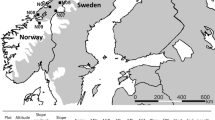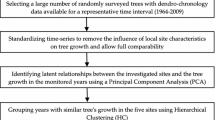Abstract
Key Message
Climate change has a significant influence on the climate-growth relationship of Scots pine in Western Hungary, and this typically expressed as a decrease in the strength of the connection between tree-ring width variation and climate data.
Abstract
This paper aims to expand our understanding of the climate-growth relationship of Scots pines in Transdanubia. Changes in the influence of climate on tree growth over various time-scales have been the subject of numerous investigations with pine trees, but these relationships have never been explored for Scots pines in Hungary. In this research, Pearson correlation values in 25-year moving windows were used to evaluate the temporal relationships of temperature, precipitation and tree-ring width variation, and additionally to investigate how these might be connected to climate change between 1915 and 2014. In the cases of summer precipitation and late winter-early spring temperature, our results detected a significant positive influence on the tree-ring width development of those Scots pines at our study sites. Furthermore, intensive warming over the last 100 years has resulted in a changing relationship between tree-ring width variation and climate data. In this study, the temporal instability of the climate-growth relationship was observed in every important month of tree-ring growth, and the response of growth to climate declined sharply in most of the studied periods. This indicates that ongoing climate change has already altered the climate-growth relationship in Scots pines in certain sites of Western Hungary.





Similar content being viewed by others
References
Bauwe A, Jurasinski G, Scharnweber T, Schröder C, Lennartz B (2015) Impact of climate change on tree-ring growth of Scots pine, common beech and pedunculate oak in northeastern Germany. iForest 9:1–11. doi:10.3832/ifor1421-008
Bauwe A, Koch M, Kallweit R, Konopatzky A, Strohbach B, Lennartz B (2013) Tree-ring growth response of Scots pine (Pinus sylvestris L.) to climate and soil water availability in the lowlands of North-Eastern Germany. Baltic For 19:212–225.
Bijak S (2010) Tree-ring chronology of silver fir and its dependence on climate of the Kaszubskie Lakeland (Northern Poland). Geochronometria 35:91–94. doi:10.2478/v10003-010-0001-9
Bogino S, Fernández MJ, Bravo F (2009) Climate effect on radial growth of Pinus sylvestris at its southern and western distribution limits. Silva Fenn 43(4):609–623.
Borhidi A (2003) Magyarország növénytársulásai. Akadémiai Kiadó, Budapest
Bozó L (2010) Környezeti jövőkép – Környezet-és klímabizottság (Ed). MTA, Budapest
Bošel’a M, Sedmák R, Sedmárková D, Marušák R, Kulla L (2013) Temporal shifts of climate–growth relationships of Norway spruce as an indicator of health decline in the Beskids, Slovakia. For Ecol Manag 325: 108–117. doi:10.1016/j.foreco.2014.03.055
Briffa K (2000) Annual climate variability in the. Holocene: interpreting the message from ancient trees Quat Sci Rev 19:87–105. doi:10.1016/S0277-3791(99)00056-6
Briffa K, Schweingruber F, Jones P, Osborn T (1998) Reduced sensitivity of recent tree growth to temperature at high norther latitudes. Nature 391:65–73. doi:10.1038/35596
Churkova OV, Eugster W, Zielis S, Cherubini P, Etzold S, Saurer M, Siegwolf R, Buchmann N (2014) Increasing relevance of spring temperatures for Norway spruce trees in Davos, Switzerland, after the 1950s. Trees Struct Funct 28:183–191. doi:10.1007/s00468-013-0941-6
Cook ER, Peters K (1981) The smoothing spline: a new approach to standardizing forest interior tree-ring width series for dendroclimatic studies. Tree-Ring Bull 41: 45–53.
Cook ER (1985) A Time series analysis approach to tree-ring standardization. Dissertation, The University of Arizona, Tucson
Cook ER, Krusic PJ (2006) ARSTAN4.1b_XP. http://www.ldeo.columbia.edu.
D’Arrigo R, Wilson R, Liepert B, Cherubini P (2008) On the ‘‘Divergence Problem’’ in northern forests: a review of the tree-ring evidence and possible causes. Glob Planet Change 60:289–305. doi:10.1016/j.gloplacha.2007.03.004
D’Arrigo R, Kaufmann R, Davi N, Jacoby G, Laskowski C, Myneni R, Cherubini P (2004) Thresholds for warming-induced growth decline at elevational treeline in the Yukon Territory. Glob Biogeochem Cycles 18. doi:10.1029/2004GB002249
de Luis M, Čufar K, Saz MA, Longares LA, Ceglar A, Kajfež-Bogataj L (2014) Trends in seasonal precipitation and temperature in Slovenia during 1951–2007. Reg Environ Change 14:1801–1810. doi:10.1007/s10113-012-0365-7
Eilmann B, Weber P, Rigling A, Eckstein D (2006) Growth reactions of Pinus sylvestris L. and Quercus pubescens Willd. to drought years at a xeric site in Valais, Switzerland. Dendrochronologia 23:121–132. doi:10.1016/j.dendro.2005.10.002
Garamszegi B, Kern Z (2014) Climate influence on radial growth of Fagus sylvatica growing near the edge of its distribution in Bükk Mts., Hungary. Dendrobiology 72: 89–97. doi:10.12657/denbio.072.008
Gulyás K, Bidló A, Horváth A (2014) Causes of the Forest Die-off in a Pinus Forest (Pinus sylvestris) in Fenyőfő. In: Polgár A, Bazsó T, Nagy G, Gálos B (eds) Local and regional challenges of climate change adaptation and green technologies. Proceedings. Sopron, Hungary, pp 60–67
Harris I, Jones PD (2015) CRU TS3.23: climatic research unit (CRU) time-series (TS) version 3.23 of high resolution gridded data of month-by-month variation in climate (Jan. 1901–Dec. 2014). Centre for Environmental Data Analysis, 09 November 2015. doi:10.5285/4c7fdfa6-f176-4c58-acee-683d5e9d2ed5.
Holmes RL (1983) Computer-assisted quality control in tree-ring dating and measurements. Tree-Ring Bulletin 43:69–78
Jacoby GC, D’Arrigo R (1995) Tree-ring width and density evidence of climatic and potential forest change in Alaska. Glob Biogeochem Cycles 9:227–234. doi:10.1029/95GB00321
Kern Z, Grynaeus A, Morgós A (2009) Reconstructed precipitation for southern Bakony Mountains (Transdanubia, Hungary) back to 1746 AD based on ring widths of oak trees. Időjárás 113: 299–314.
Kern Z, Patkó M, Kázmér M, Fekete J, Kele S, Pályi Z (2013) Multiple tree-ring proxies (earlywood width, latewood width and δ13C) from pedunculate oak (Quercus robur L.), Hungary. Quatern Int 239:257–267. doi:10.1016/j.quaint.2012.05.037
Koprowski M (2012) Long-term increase of March temperature has no negative impact on tree rings of European larch (Larix decidua) in lowland Poland. Trees Struct Funct 26:1895–1903. doi:10.1007/s00468-012-0758-8
Koprowski M (2013) Spatial distribution of introduced Norway spruce growth in lowland Poland: The influence of changing climate and extreme weather events. Quatern Int 283:139–146 doi:10.1016/j.quaint.2012.04.020
Luterbacher J, Dietrich D, Xoplaki E, Grosjean M, Wanner H (2004) European seasonal and annual temperature variability, trends, and extremes since 1500. Science 330:1499–1503. doi:10.1126/science.1093877
Menzel A, Fabian P (1999) Growing season extended in Europe. Nature 397:659. doi:10.1038/17709
Michelot A, Bréda N, Damesin C, Dufrene E (2012) Differing growth responses to climatic variations and soil water deficits of Fagus sylvatica, Quercus petraea and Pinus sylvestris in a temperate forest. For Ecol Manag 265: 161–171. doi:10.1016/j.foreco.2011.10.024
Misi D, Náfrádi K (2016a) Possibility of identification of negative extreme climatic events using Pinus sylvestris tree-rings in Transdanubia, Hungary. Dendrobiology 75:45–54. doi:10.12657/denbio.075.005
Misi D, Náfrádi K (2016b) Late winter—early spring thermal conditions and their long-term effect on tree-ring growth in Hungary. Baltic For 22(2):203–211
Mérian P, Pierrat J-C, Lebourgeois F (2013) Effect of sampling effort on the regional chronology statistics and climate-growth relationships estimation. Dendrochronologia 31:58–67 doi:10.1016/j.dendro.2012.07.001
NFCSO Forestry Directorate Forest Inventory 2010–2014. http://portal.nebih.gov.hu/documents/531011/531862/2001101001000.pdf/c9a01ba7-184a-4a76-9400-59387aee2df8
Náfrádi K, Jakab G, Sümegi P, Szelepcsényi Z, Törőcsik T (2013) Future climate impacts in woodland and forest steppe based on Holocene paleoclimatic trends, paleobotanical change in central part of the Carpathian Basin (Hungary). Am J Plant Sci 4:1187–1203. doi:10.4236/ajps.2013.46147
Panayotov M, Zafirov N, Cherubini P (2013) Fingerprints of extreme climate events in Pinus sylvestris tree rings from Bulgaria. Trees Struct Funct 27: 211–227. doi:10.1007/s00468-012-0789-1
Parry ML, Canziani OF, Palutikof JP, van der Linden PJ, Hanson CE (2007) IPCC, 2007: Climate Change 2007: Impacts, adaptation and Vilnerability. Contribution of Working Group II to the Fourth Assessment Report of the Intergovernmental Panel on Climate Change. Cambridge University Press, Cambridge
Poljanšek J, Ceglar A, Levanič T (2013) Long-term summer sunshine/moisture stress reconstruction from tree-ring widths from Bosnia and Herzegovina. Clim Past 9:27–40. doi:10.5194/cp-9-27-2013
Pärn H (2009) Temporal history of relationships between Scots pine (Pinus sylvestris L.) radial growth and mean monthly temperatures. Baltic For 15:48–57.
Reich PB, Oleksyn J (2008) Climate warming will reduce growth and survival of Scots pine except in the far north. Ecol Lett 11:588–597. doi:10.1111/j.1461-0248.2008.01172.x
Rinn F (2003) TSAP-Win—time series analysis and presentation for dendrochronology and related applications. User Reference, Heidelberg
Sánchez-Salguero R, Camarero JJ, Hevia A, Madrigal-González J, Linares JC, Ballesteros-Canovas JA, Sánchez-Miranda A, Alfaro-Sánchez R, Sangüesa-Barreda G, Galván JD, Gutiérrez E, Génova M, Rigling A (2015) What drives growth of Scots pine in continental Mediterranean climates: drought, low temperatures or both? Agr Forest Meteorol 206:151–162. doi:10.1016/j.agrformet.2015.03.004
Vaganov E, Hughes M, Kirdyanov A, Schweingruber F, Silkin P (1999) Influence of snowfall and melt timing on tree growth in Subarctic Eurasia. Nature 400:149–151. doi:10.1038/22087
Wigley TML, Briffa KR, Jones PD (1984) On the average value of correlated time series, with applications in dendroclimatology and hydrometeorology. J Clim Appl Meteorol 23:201–213. doi:10.1175/1520-0450(1984)023<0201:OTAVOC>2.0.CO;2
Wilson RJS, Luckman BH (2003) Dendroclimatic reconstruction of maximum summer temperatures from upper tree-line sites in interior British Columbia. Holocene 13:853–863. doi:10.1191/0959683603hl663rp
Xoplaki E, Lutherbacher J, Paeth H, Dietrich D, Steiner N, Grosjean M, Wanner H (2005) European spring and autumn temperature variability and change of extremes over the last half millennium. Geophys Res Lett 32:L15713. doi:10.1029/2005GL023424
Acknowledgements
The authors would like to express their gratitude to Ms. Rita Márkus and to Mr. Szabolcs Borka for their invaluable help during sampling, and to Mr. Zoltán Kern for organizing the sample preparation and measurement. We also would like to thank the two reviewers and the editor of this paper for their valuable advice and comments.
Author information
Authors and Affiliations
Corresponding author
Ethics declarations
Conflict of interest
The authors declare that they have no conflict of interest.
Additional information
Communicated by S. Leavitt.
Rights and permissions
About this article
Cite this article
Misi, D., Náfrádi, K. Growth response of Scots pine to changing climatic conditions over the last 100 years: a case study from Western Hungary. Trees 31, 919–928 (2017). https://doi.org/10.1007/s00468-016-1517-z
Received:
Accepted:
Published:
Issue Date:
DOI: https://doi.org/10.1007/s00468-016-1517-z




